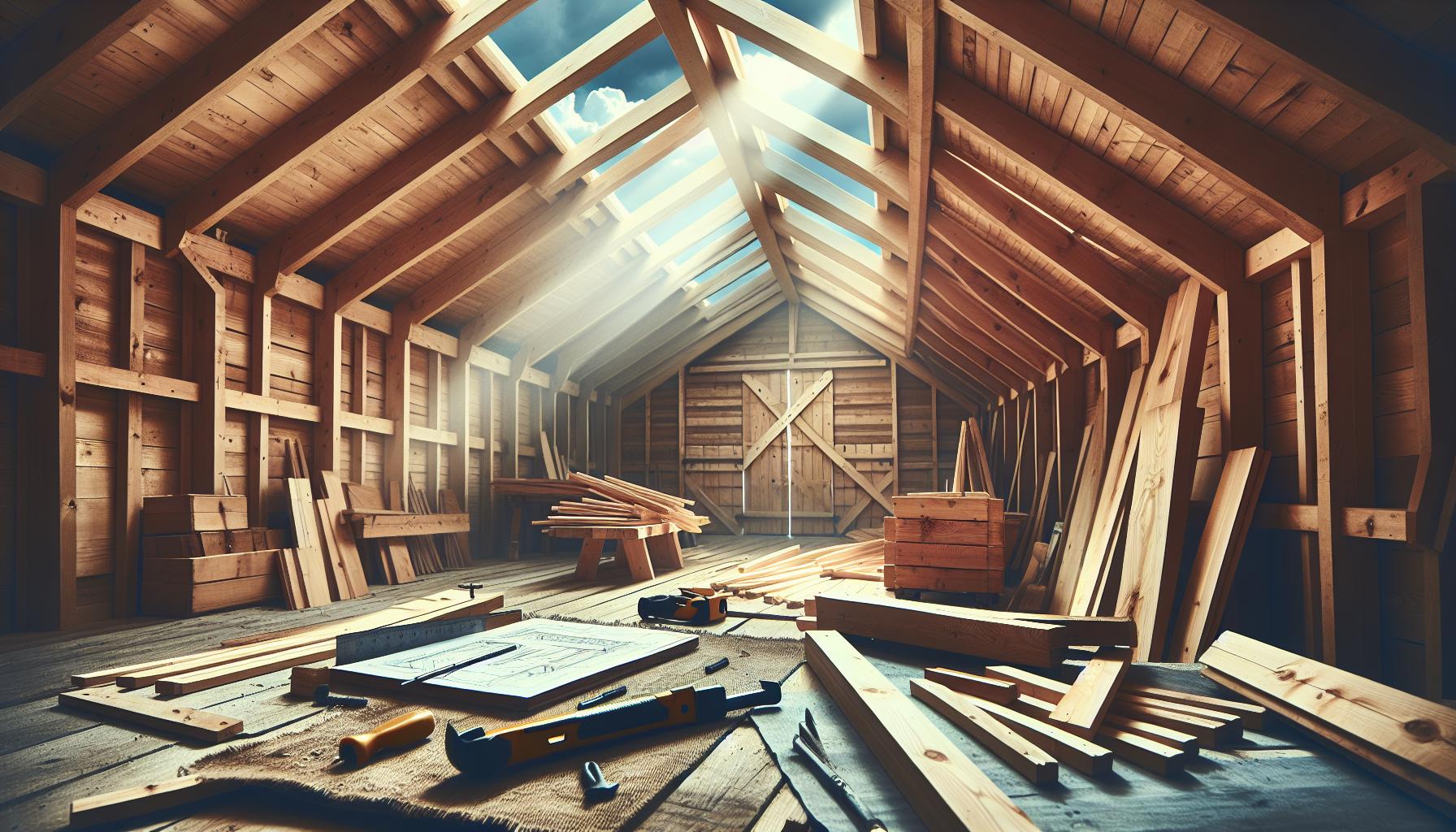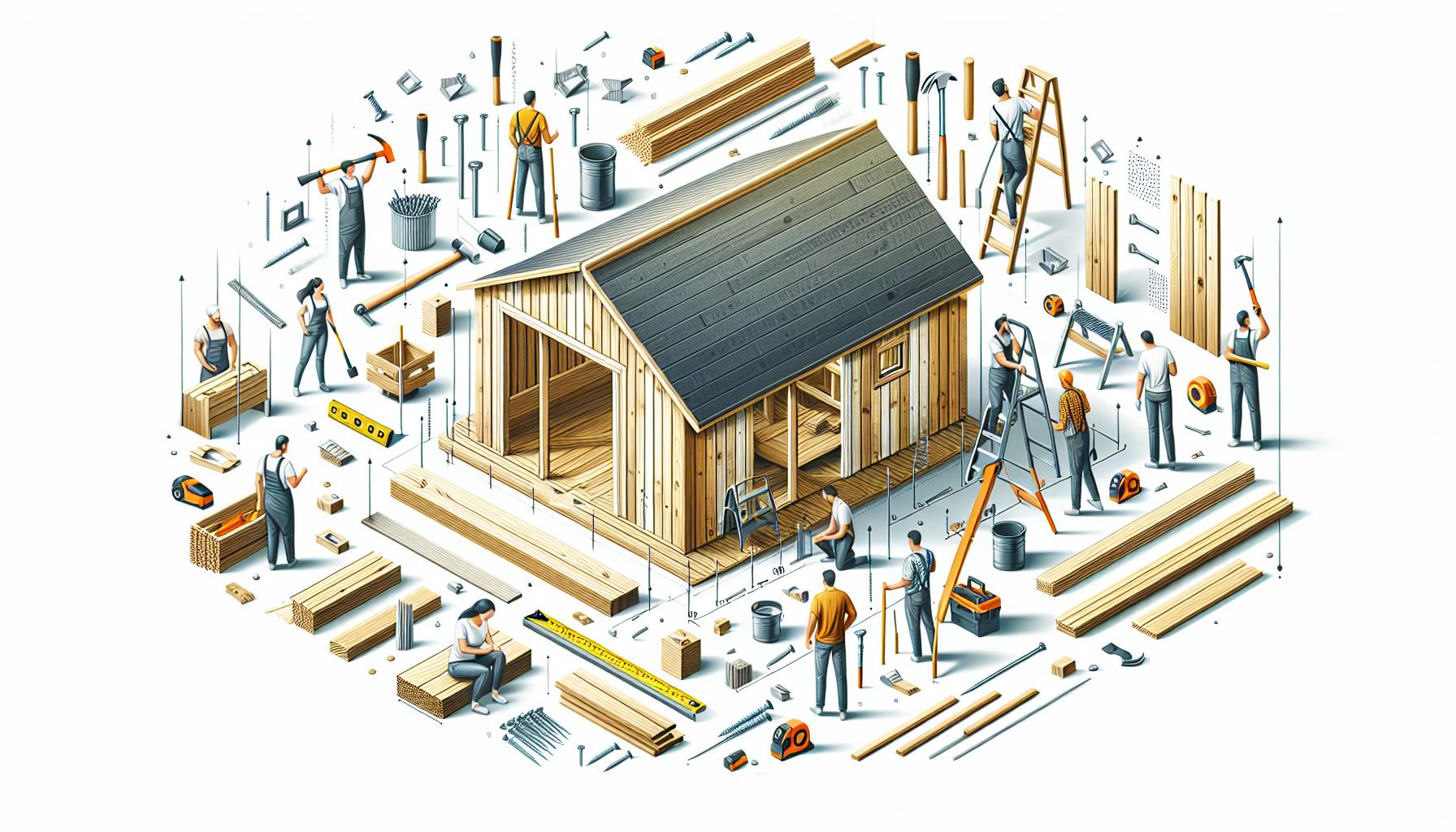When fierce winds whip through your region, a shed that isn’t properly secured can quickly become a costly liability. Understanding the necessity of anchoring your outdoor storage not only protects your investment but also ensures safety and longevity. Learn why wind protection is vital for sheds, irrespective of your local climate.
Understanding the Importance of Anchoring Your Shed
Properly securing your shed is an essential aspect that should not be overlooked.Every year, thousands of sheds are damaged or destroyed due to high winds and severe weather conditions. Without effective anchoring, your storage solution could easily become a projectile, perhaps causing injury and property damage. Understanding how and why to anchor your shed is vital, particularly if you live in an area prone to storms, hurricanes, or tornadoes.
Why Anchoring Matters
Sheds,like any other structure,face the risk of being lifted or moved by strong winds. When considering weather you need to anchor your shed, several factors come into play:
- Location: Regions with high wind speeds or frequent storms should prioritize anchoring.
- Size and weight: Lighter sheds or those made from less sturdy materials are more vulnerable to wind.
- Ground conditions: Loose or sandy soils may not provide adequate stability for a freestanding structure.
In areas where harsh weather is a common occurence, the question “Do I need to anchor my shed?” becomes not just relevant but crucial. By securely anchoring your shed, you protect your investment and ensure that the contents inside remain safe from the elements and potential theft.
Types of Anchoring Systems
There are several methods to anchor a shed, each suitable for different conditions and types of storage structures:
- Ground anchors: Thes include screw-type anchors and concrete pier systems that firmly grip the ground to secure your shed.
- Concrete footings: Pouring a concrete slab or footing where your shed sits can significantly improve stability.
- Cable systems: Using heavy-duty cables linked to ground anchors offers additional support, particularly for larger structures.
Choosing the right anchoring technique is essential, as it directly impacts the safety and longevity of your shed.
Practical Steps for Anchoring Your shed
To effectively anchor your shed, consider following these steps:
- Evaluate Your Environment: Identify potential wind speeds andstorm patterns in your region.
- Choose Your Anchoring Method: Select a suitable anchoring mechanism based on your shed’s design and soil type.
- Install Properly: Follow manufacturer guidelines for installation to ensure maximum effectiveness.
- Regular Maintainance: Check the integrity of your shed and anchors periodically, especially after severe weather events.
By being proactive and anchoring your shed, you not only enhance its resilience against natural forces but also contribute to your overall peace of mind.Investing time and effort into these measures can save you from costly repairs or replacements in the future. Always remember, the right protection system tailored to your unique conditions can safeguard your shed for years to come.
How Wind Forces Affect Different Shed Designs
Understanding how wind forces impact different shed designs is essential for anyone considering outdoor storage.A robust shed can withstand harsh weather, but not all designs are created equal when it comes to handling strong winds. various factors, such as shape, materials, and anchoring techniques, play a pivotal role in ensuring the longevity and stability of your shed against the elements.
factors Influencing Wind Resistance
The ability of a shed to withstand wind forces depends on its design features. Here are several key aspects to consider:
- Shape: Aerodynamic shapes, such as sloped roofs, can help minimize wind resistance. Sheds with flat roofs are more vulnerable to uplift forces in high winds.
- Material: The materials used in constructing your shed greatly affect its resilience. Heavy-duty materials like steel or reinforced wood hold up better against gale-force winds compared to lightweight materials.
- Height and Width: taller, narrower structures tend to be more stable under wind forces than short, wide ones. A well-proportioned shed can help distribute wind pressure more evenly.
- Foundation and Anchoring: Regardless of the shed’s design, proper anchoring can make a important difference. Using appropriate anchoring methods tailored to your region is crucial for wind protection.
Design Considerations Based on Wind Regions
In areas susceptible to high winds or hurricanes, specific design elements can enhance the stability of sheds. The table below outlines recommended features based on different wind prone zones:
| Wind Zone | Recommended Shed features | Anchoring Techniques |
|---|---|---|
| Low Wind (< 30 mph) | Standard gable roof, light wood structure | basic anchor bolts |
| Moderate Wind (30-50 mph) | Sloped roof, reinforced walls | Heavy-duty anchor straps |
| High Wind (50 mph +) | Low-profile design, weighty materials | Concrete anchors, ground screws |
the question of whether to anchor your shed is tied closely to its design and anticipated wind forces in your area. Understanding these factors can help you choose materials, features, and anchoring methods that best suit your needs. By adapting your shed design to align with local wind conditions, you can significantly enhance its durability and structural integrity.
Regional Considerations: Tailoring Wind Protection for Your Area
Understanding your local climate is crucial in deciding how to protect your shed from wind. Regions prone to high winds or hurricanes necessitate different strategies compared to areas with mild breezes. The question of whether to anchor your shed hinges on these regional characteristics, including soil type, typical wind speeds, and local weather patterns that influence the risk of strong gusts.
Identifying Wind Zones
Certain areas are more susceptible to extreme weather,wich directly affects how you should secure your shed. It’s essential to identify your wind zone—locations like coastal areas, plains, and elevated regions often experience more significant wind impacts. Here are some considerations for different regions:
- Coastal Regions: Properties near the coast face harsh winds and storms.Bottom anchoring with stakes or brackets along with additional support from windbreaks like trees or shrubs can be effective protective measures.
- Flat Plains: High wind speeds can be a concern in open areas.Here, anchoring becomes essential. Consider using concrete blocks or even installing your shed on a concrete slab to increase stability.
- Mountainous Areas: The wind can be channeled through valleys and can create unpredictably strong gusts. In these settings, secure anchoring combined with robust construction materials is vital to withstand sudden wind events.
- Urban environments: Tall buildings can create wind tunnels. Investing in better anchoring methods and ensuring your shed is low-profile can definately help mitigate these effects.
Soil Considerations
The type of soil where your shed is installed can significantly affect how well it can be anchored. Here’s a quick look at common soil types and how they impact anchoring:
| Soil Type | Anchor Recommendations |
|---|---|
| Clay | Use deep anchors, like screws or stakes, as clay can shift during wet conditions. |
| Sandy | Opt for wider base anchors to distribute weight and resist lifting. |
| Loamy | Standard stakes usually work well, but assess moisture levels, especially in spring. |
| Rocky | Utilizing concrete or bolt-down anchors may provide the necessary resistance. |
Incorporating these regional considerations is vital when addressing the question, “Do I need to anchor my shed? Wind protection for every region.” Your approach should not only reflect local environmental conditions but also adapt over time, as changes in weather patterns continue to emerge. By taking these proactive steps, you can ensure that your shed remains safe and secure, regardless of the winds that may blow your way.
Step-by-Step Guide to Anchoring Your Shed Safely
When it comes to protecting your shed, proper anchoring is crucial, especially in regions prone to high winds. A well-anchored shed not only withstands severe weather but also extends its lifespan. In this guide, we’ll walk you through the essential steps to secure your shed effectively, ensuring it’s anchored against the elements.
Assess Your Shed’s Location
Before you dive into the anchoring process, evaluate your shed’s site.Factors to consider include:
- Soil Type: Sandy or loose soil may require different anchoring techniques than clay or hard-packed ground.
- Wind Exposure: Is your shed located near trees, buildings, or other structures? These can either shield or direct wind towards your shed.
- Local Regulations: Some areas have specific building codes regarding shed anchoring—always check local guidelines first.
Gathering this details will help determine the best anchoring method suited for your situation and conditions.
Choose the Right Anchoring Method
Once you have assessed the location of your shed, the next step is to select an appropriate anchoring technique. Here are a few popular methods:
| Anchoring Method | Best For | Installation Difficulty |
|---|---|---|
| Ground Anchors | Loose or sandy soil | Moderate |
| Concrete Blocks | Most soil types | Easy |
| Lag Screws | Wooden sheds or decks | Moderate |
| Anchor Straps | Heavy-duty sheds | easy |
Each of these methods has unique advantages and can be tailored to meet your specific needs. Ensure to follow product guidelines for the best results.
Implementing the Anchoring System
After selecting your anchoring method, it’s time to put it into action.Here’s a simplified process based on different techniques:
- Ground Anchors: Drive anchors into the ground at least 2 feet deep. connect them to your shed with heavy-duty straps.
- Concrete Blocks: Place a concrete block at each corner of the shed, ensuring they’re evenly spaced. Use tie-down straps to attach the shed to the blocks securely.
- Lag Screws: If your shed is on a wood platform,install lag screws through the base of the shed into the platform,ensuring a tight fit.
- Anchor Straps: Wrap the straps around the shed and stake them into the ground, adjusting for tension based on wind conditions.
Following these steps can significantly reduce the risk of your shed being uprooted or damaged in strong winds,offering peace of mind regardless of where you live.
By anchoring your shed according to your region’s wind protection needs, you’ll ensure that your investment remains secure and functional for years to come.
Choosing the Right Anchoring Materials for Your Shed
When contemplating the stability of your shed, the right anchoring materials can make a world of difference in ensuring its longevity and safety. Particularly in regions prone to severe weather, understanding your options for anchoring materials is crucial. Exploring the different types of anchors can help you choose the best fit for your specific needs.
types of Anchoring Materials
There are several types of anchoring materials to consider based on the soil type,climate,and local weather patterns. some of the most common options include:
- Concrete Anchors: Ideal for areas with high winds, concrete anchors are generally the most robust solution. They can be poured directly into the ground and secured to the shed’s base.
- Auger Anchors: These are screw-like anchors that are ideal for soft or sandy soil.They screw into the ground and can provide strong hold when installed correctly.
- Hurricane Straps: if your shed is built on a foundation,hurricane straps can definitely help secure the shed to the foundation and are an effective method in hurricane-prone areas.
- Ground Stakes: Simple and effective, these metal stakes drive into the ground to tether the shed. They are best for lightweight sheds and sandy or loose soil.
Factors to Consider When Choosing Anchors
To select the appropriate anchoring materials, consider the following factors:
- Soil Type: The composition of your soil significantly affects anchor performance. Clay soils may require deeper or more robust anchors due to their compaction characteristics, while sandy soils might benefit from auger-style anchors.
- Wind Zones: Review local building codes to determine recommended anchoring guidelines based on your wind zone. Use stronger anchors in regions with frequent high winds.
- Weight of the Shed: Heavier structures often require more substantial anchoring systems, while lighter sheds can use simpler, less invasive options.
- Local Regulations: Always be mindful of local regulations that might dictate the types of foundations or anchoring methods permitted in your area.
Real-World Applications
selecting the right anchor type could mean the difference between a shed standing strong through the fiercest storms or succumbing to the elements.For example, a homeowner in a hurricane-prone area might opt for concrete anchors paired with hurricane straps, ensuring their shed remains intact during severe weather. Conversely, a gardener in a temperate zone could successfully rely on ground stakes for their lightweight garden shed, enjoying peace of mind without excessive costs.
| Anchor Type | Best For | Soil Conditions | Cost Effectiveness |
|---|---|---|---|
| Concrete Anchors | Heavy-duty protection against high winds | All types, particularly stable ground | Moderate to High |
| Auger Anchors | Soft or sandy soils | Sandy, loamy | Low to Moderate |
| Hurricane Straps | Regionally mandated installations | Solid foundations | Low |
| ground Stakes | Lightweight structures in low-wind areas | Sandy or loose | Very Low |
By carefully analyzing your region’s specific risks as outlined in “Do I Need to Anchor My Shed? wind Protection for Every Region,” and selecting the appropriate anchoring solutions, you can ensure that your shed remains a secure and reliable space for years to come.
DIY vs. Professional Help: When to Call an Expert
When it comes to wind protection for your shed, understanding whether to tackle the task yourself or to call in a professional can make all the difference in ensuring longevity and safety. Both DIY enthusiasts and those seeking expert help have their merits, but recognizing when to switch gears can save you time, effort, and potential headaches.
Assessing the Complexity of the Project
Before making any decisions, it’s crucial to evaluate the specific needs of your shed based on its location and the wind conditions prevalent in your region. Here are some factors to consider:
- Size and Type of Shed: Larger or heavier structures may require more rigorous anchoring techniques, which might be beyond average DIY capabilities.
- Soil Composition: if your shed is on sandy or loose soil, that may necessitate deeper or more complex anchoring methods.
- Regional Wind Speeds: Areas known for harsh storms could benefit from enhanced wind protection strategies, making professional assessment beneficial.
If the project appears straightforward—such as adding concrete blocks or using simple tie-downs—you might find it manageable to take on yourself. However, if you’re unsure about the correct anchoring methods or the materials required, it’s wise to consult an expert.
Cost Considerations
another vital aspect to weigh is your budget. DIY projects can frequently enough save money in labor costs, but mistakes can lead to expensive repairs in the long run. Here’s a simple table comparing DIY versus professional help in terms of cost and risk:
| Factor | DIY | Professional Help |
|---|---|---|
| Initial Cost | Lower | Higher |
| Time Investment | Variable | Fixed |
| Risk of Mistakes | Higher | Lower |
| long-term Reliability | Variable | Generally Higher |
Ultimately, if you opt for a DIY route, ensure you’re following proper guidelines for your specific conditions.On the other hand,if the situation seems overwhelming,collaborating with professionals could lead to more sustainable solutions,particularly in extreme weather areas where the question of “Do I Need to Anchor My Shed?” is more pressing.
Evaluating Your Skills and Equipment
Before making your final decision, honestly assess your skills and the tools at your disposal. If you have experience in construction and access to quality materials, DIY might be the way to go. However, if you feel out of your depth, calling in professionals can guarantee that you’re not only safe but also compliant with local building codes.
In sum, weighing the complexity of the project, associated costs, and your own comfort level with DIY skills will help you determine the most effective path forward for wind protection in your shed.Engaging with professionals guarantees peace of mind,especially in regions vulnerable to high winds,ensuring your investment is protected against the elements.
Common Mistakes to Avoid When Securing Your Shed
When it comes to ensuring the safety and longevity of your shed, overlooking the basics can be surprisingly detrimental. Many homeowners make various mistakes that could compromise the integrity of their storage space, especially when dealing with adverse weather conditions. Knowing what not to do is just as critical as understanding the necessary precautions for securing your shed against the elements.
Misjudging Local Weather Conditions
One of the primary mistakes is failing to consider the specific weather patterns of your region.While some areas may breathe easy during mild winds,others might frequently face gusty conditions. If you’re asking, “Do I need to anchor my shed?” the answer should be tailored to your local climate.
- Research Past data: investigate past weather events in your locality to determine the usual wind speeds and storm occurrences.
- Adjust Based on Seasonal Changes: Remember that wind strength can vary by season; plans might need adjustments accordingly.
Neglecting Proper Anchoring Techniques
Another frequent oversight is improperly anchoring the shed. Just placing a few blocks or weights on the ground won’t cut it. Depending on your shed’s location and the material it’s made from, a sturdy anchor system is essential to resist high winds effectively.
- Choose the Right Anchoring Material: Opt for brackets and bolts that are durable and suited to both the shed’s design and local soil conditions.
- Consult Professional Guidance: If unsure about the best practices for your shed’s installation, seeking help from a contractor with experience in construction or landscaping can be invaluable.
Overlooking Routine Maintenance
Sheds, like any structure, require regular upkeep. It’s easy to forget about your shed until a storm approaches, but neglecting minor repairs can lead to significant problems.
- Inspect for Damage: Regularly check for loose screws, rust, and leaks, which could weaken the overall structure.
- Check the Foundation: examine the base and ensure that it remains level; a displaced foundation can lead to instability, especially in high winds.
By steering clear of these missteps, you’ll be much more prepared when asking, “Do I need to anchor my shed?” Whether to tackle windy conditions or other weather-related challenges in your area, a well-secured shed will stand strong against the elements. Planning ahead and taking action not only protects your investment but also provides peace of mind.
FAQ
Do I Need to Anchor My Shed? Wind Protection for Every Region?
Yes, anchoring your shed is essential for wind protection, especially in regions prone to high winds. Proper anchoring helps prevent structural damage and prolongs the life of your shed.
Wind can exert significant pressure on a shed, potentially leading to tipping or uprooting. By using ground anchors or other anchoring methods, you create a secure foundation that protects against harsh weather conditions. Anchoring is a vital part of long-term shed maintenance that ensures stability.
how do I anchor my shed to a concrete slab?
To anchor your shed to a concrete slab, use concrete anchor bolts or brackets. This method provides excellent stability and is ideal for areas with high wind exposure.
Start by drilling holes into the concrete slab. Insert the anchor bolts or brackets and tighten securely. This straightforward process can significantly enhance your shed’s resistance to wind forces.For detailed instructions, check this guide.
What types of anchors are best for sheds?
The best types of anchors for sheds include ground anchors,auger anchors,and concrete screw anchors. Each type has strengths based on soil conditions and wind exposure.
Ground anchors penetrate the soil, creating a strong hold, while auger anchors twist into the ground, offering stability in loose soil. Concrete screw anchors are perfect for shed installations on concrete,ensuring excellent wind protection. Choose the appropriate anchor based on your specific needs.
Why does my shed need to be anchored?
Your shed needs to be anchored to prevent it from being damaged or blown away by strong winds. Anchoring provides the necessary stability to withstand severe weather conditions.
Unanchored sheds can shift, tip, or even collapse during storms, leading to costly repairs or replacements. By securing your shed, you ensure it remains safe and intact, protecting your valuables inside. Strong anchoring will greatly enhance your shed’s durability.
Can I anchor my shed without professional help?
Yes, you can anchor your shed without professional help. Many homeowners successfully complete this task with basic tools and materials, especially with detailed instructions.
Begin by assessing your shed’s location and choosing the right type of anchors. Follow online guides or tutorials that provide step-by-step instructions. This DIY project builds confidence and ensures you can properly secure your shed against wind damage.
how often should I check my shed anchors?
You should check your shed anchors at least once a year, or after extreme weather events. Regular inspections ensure that your anchors remain secure and effective.
During your check, look for any signs of rust, loosening, or damage. Addressing issues promptly will help maintain the integrity of your shed. Consistent maintenance is part of good shed ownership, ultimately safeguarding your investment.
What happens if I don’t anchor my shed?
If you don’t anchor your shed, it is indeed at a higher risk of damage from high winds or severe weather.This could lead to structural failure and loss of stored items.
Unanchored sheds may shift position or collapse, leading to costly repairs and potential injuries. Investing time in proper anchoring can save you significant hassle down the road and ensure your shed’s safety during adverse weather.
In Summary
anchoring your shed is a vital step to ensure its longevity and stability, particularly in regions prone to strong winds. By understanding your local climate and implementing the right anchoring techniques—whether that’s using ground spikes, concrete blocks, or anchors—you can protect your investment effectively. Remember, the key is to assess your specific needs and choose a method that feels manageable for you, regardless of your DIY experience. Don’t hesitate to explore additional resources or consult with fellow DIYers for tips and tricks that can ease your project’s journey. Quality craftsmanship is within reach, and with the right guidance, you can confidently build a shed that withstands the elements. Happy building, and may your shed be a sturdy haven for years to come!







